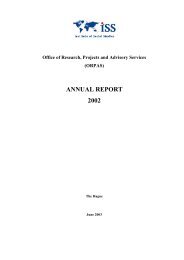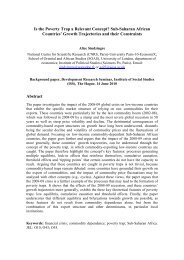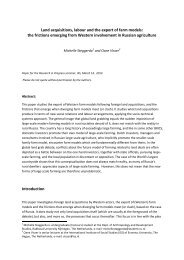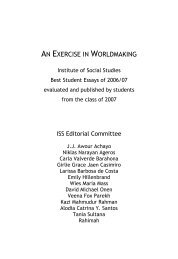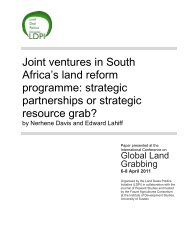AN EXERCISE IN WORLDMAKING 2009 - ISS
AN EXERCISE IN WORLDMAKING 2009 - ISS
AN EXERCISE IN WORLDMAKING 2009 - ISS
Create successful ePaper yourself
Turn your PDF publications into a flip-book with our unique Google optimized e-Paper software.
184 TARA TABASSI<br />
as a teller of other human beings’ stories, what does it mean when a story<br />
is taken, printed and distributed far from its source? In Orientalism, Said<br />
explains: “the Orientalist’s presence is enabled by the Orient’s effective<br />
absence” (1978:208). Precisely because the source of a representation is<br />
not the person/group/country represented, the representer can enable a<br />
new kind of essentializing discourse. Does this affect the ‘comfortable<br />
sense of being a good, socially proper and stable person’? (Johnstone<br />
2001:640-1) Who is a good person and who is not? Where is the humanity<br />
of the person whose story it ‘is’ and more critically, what value is<br />
given to the people/institutions who make profit from taking that story?<br />
To whom is a story told, by whom, and for what purpose?<br />
Methodology<br />
Framed by the above questions, Narrative Analysis will be used, structured<br />
by five of Labov’s personal experience narrative (PEN) clauses: (1)<br />
Abstract; (2) Orientation; (3) Complicating Action; (4) Result/Resolution;<br />
and (5) Coda. Johnstone defines ‘narratives’ as talk about past<br />
events and ‘story’ as narrative with a point (2001:636-9). NatGeo’s stories<br />
are arguably presented as ‘first-hand’ data and interpreted as reality.<br />
Johnstone’s definition becomes meaningful if NatGeo is interpreted as a<br />
creator of discourse with specific agendas, following Said’s analysis that<br />
every representation is political and therefore specific agendas (1978:11).<br />
Roe’s work applies fairytale structure and questions ‘“real” world versus<br />
fiction’ in the context of development literature, arguing that ‘storification’<br />
occurs due to demand for writing that ‘holds together’ without fragmentation,<br />
developed by a cast: Villain, Hero, Victim, Magical Object,<br />
Magic Helper, Obstacles, and Journey (1989:1-2). Analyzing an article as<br />
a whole, seamless narrative, presenting heroes and demons, illuminates<br />
the structures necessary for readers to believingly follow discourse.<br />
Text will be analyzed with special attention to metaphor, underlying<br />
assumptions and ‘constructed dialogues’ created for characters by the<br />
narrator (Johnstone 2001:640). Overall narrative analysis will be complemented<br />
by rudimentary visual analysis of related images in order to<br />
understand the story’s function.




